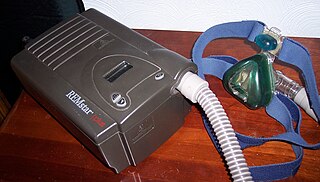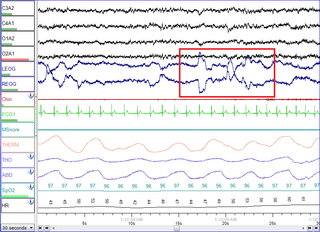Related Research Articles

Sleep apnea, also spelled sleep apnoea, is a sleep disorder in which pauses in breathing or periods of shallow breathing during sleep occur more often than normal. Each pause can last for a few seconds to a few minutes and they happen many times a night. In the most common form, this follows loud snoring. There may be a choking or snorting sound as breathing resumes. Because the disorder disrupts normal sleep, those affected may experience sleepiness or feel tired during the day. In children, it may cause hyperactivity or problems in school.

A sleep disorder, or somnipathy, is a medical disorder of an individual's sleep patterns. Some sleep disorders are severe enough to interfere with normal physical, mental, social and emotional functioning. Polysomnography and actigraphy are tests commonly ordered for diagnosing sleep disorders.
Apnea, BrE: apnoea, is the temporal cessation of breathing. During apnea, there is no movement of the muscles of inhalation, and the volume of the lungs initially remains unchanged. Depending on how blocked the airways are, there may or may not be a flow of gas between the lungs and the environment, but if there's sufficient flow, gas exchange within the lungs and cellular respiration wouldn't be severely affected. Voluntarily doing this is called holding one's breath. Apnea may first be diagnosed in childhood, and it is recommended to consult an ENT specialist, allergist or sleep physician to discuss symptoms when noticed; malformation and/or malfunctioning of the upper airways may be observed by an orthodontist.

Obesity hypoventilation syndrome (OHS) is a condition in which severely overweight people fail to breathe rapidly or deeply enough, resulting in low oxygen levels and high blood carbon dioxide (CO2) levels. The syndrome is often associated with obstructive sleep apnea (OSA), which causes periods of absent or reduced breathing in sleep, resulting in many partial awakenings during the night and sleepiness during the day. The disease puts strain on the heart, which may lead to heart failure and leg swelling.

Positive airway pressure (PAP) is a mode of respiratory ventilation used in the treatment of sleep apnea. PAP ventilation is also commonly used for those who are critically ill in hospital with respiratory failure, in newborn infants (neonates), and for the prevention and treatment of atelectasis in patients with difficulty taking deep breaths. In these patients, PAP ventilation can prevent the need for tracheal intubation, or allow earlier extubation. Sometimes patients with neuromuscular diseases use this variety of ventilation as well. CPAP is an acronym for "continuous positive airway pressure", which was developed by Dr. George Gregory and colleagues in the neonatal intensive care unit at the University of California, San Francisco. A variation of the PAP system was developed by Professor Colin Sullivan at Royal Prince Alfred Hospital in Sydney, Australia, in 1981.

Cheyne–Stokes respiration is an abnormal pattern of breathing characterized by progressively deeper, and sometimes faster, breathing followed by a gradual decrease that results in a temporary stop in breathing called an apnea. The pattern repeats, with each cycle usually taking 30 seconds to 2 minutes. It is an oscillation of ventilation between apnea and hyperpnea with a crescendo-diminuendo pattern, and is associated with changing serum partial pressures of oxygen and carbon dioxide.

Central hypoventilation syndrome (CHS) is a sleep-related breathing disorder that causes ineffective breathing, apnea, or respiratory arrest during sleep. CHS can either be congenital (CCHS) or acquired (ACHS) later in life. The condition can be fatal if untreated. CCHS was once known as Ondine's curse.

Polysomnography (PSG), a type of sleep study, is a multi-parameter study of sleep and a diagnostic tool in sleep medicine. The test result is called a polysomnogram, also abbreviated PSG. The name is derived from Greek and Latin roots: the Greek πολύς, the Latin somnus ("sleep"), and the Greek γράφειν.

Obstructive sleep apnea (OSA) is the most common sleep-related breathing disorder and is characterized by recurrent episodes of complete or partial obstruction of the upper airway leading to reduced or absent breathing during sleep. These episodes are termed "apneas" with complete or near-complete cessation of breathing, or "hypopneas" when the reduction in breathing is partial. In either case, a fall in blood oxygen saturation, a disruption in sleep, or both may result. A high frequency of apneas or hypopneas during sleep may interfere with restorative sleep, which – in combination with disturbances in blood oxygenation – is thought to contribute to negative consequences to health and quality of life. The terms obstructive sleep apnea syndrome (OSAS) or obstructive sleep apnea–hypopnea syndrome (OSAHS) may be used to refer to OSA when it is associated with symptoms during the daytime.
The respiratory rate is the rate at which breathing occurs; it is set and controlled by the respiratory center of the brain. A person's respiratory rate is usually measured in breaths per minute.
Freediving blackout, breath-hold blackout or apnea blackout is a class of hypoxic blackout, a loss of consciousness caused by cerebral hypoxia towards the end of a breath-hold dive, when the swimmer does not necessarily experience an urgent need to breathe and has no other obvious medical condition that might have caused it. It can be provoked by hyperventilating just before a dive, or as a consequence of the pressure reduction on ascent, or a combination of these. Victims are often established practitioners of breath-hold diving, are fit, strong swimmers and have not experienced problems before. Blackout may also be referred to as a syncope or fainting.
Rhythmic movement disorder (RMD) is a neurological disorder characterized by repetitive movements of large muscle groups immediately before and during sleep often involving the head and neck. It was independently described first in 1905 by Zappert as jactatio capitis nocturna and by Cruchet as rhythmie du sommeil. The majority of RMD episodes occur during NREM sleep, although REM movements have been reported. RMD is often associated with other psychiatric conditions or mental disabilities. The disorder often leads to bodily injury from unwanted movements. Because of these incessant muscle contractions, patients' sleep patterns are often disrupted. It differs from restless legs syndrome in that RMD involves involuntary muscle contractions before and during sleep while restless legs syndrome is the urge to move before sleep. RMD occurs in both males and females, often during early childhood with symptoms diminishing with age. Many affected individuals also have other sleep related disorders, like sleep apnea. The disorder can be differentially diagnosed into small subcategories, including sleep related bruxism, thumb sucking, hypnagogic foot tremor, and rhythmic sucking, to name a few. In order to be considered pathological, the ICSD-II requires that in the sleep-related rhythmic movements should “markedly interfere with normal sleep, cause significant impairment in daytime function, or result in self-inflicted bodily injury that requires medical treatment ”.
Apnea of prematurity is defined as cessation of breathing by a premature infant that lasts for more than 20 seconds and/or is accompanied by hypoxia or bradycardia. Apnea is traditionally classified as either obstructive, central, or mixed. Obstructive apnea may occur when the infant's neck is hyperflexed or conversely, hyperextended. It may also occur due to low pharyngeal muscle tone or to inflammation of the soft tissues, which can block the flow of air though the pharynx and vocal cords. Central apnea occurs when there is a lack of respiratory effort. This may result from central nervous system immaturity, or from the effects of medications or illness. Many episodes of apnea of prematurity may start as either obstructive or central, but then involve elements of both, becoming mixed in nature.
When we sleep, our breathing changes due to normal biological processes that affect both our respiratory and muscular systems.
The Apnea–Hypopnea Index or Apnoea–Hypopnoea Index (AHI) is an index used to indicate the severity of sleep apnea. It is represented by the number of apnea and hypopnea events per hour of sleep. Apnea is the complete absence of airflow through your nose and mouth. Hypoapnea is a partial collapse of your airway, limiting breathing. Apneas must last for at least 10 seconds and be associated with a decrease in blood oxygenation to be considered. Combining AHI and oxygen desaturation gives an overall sleep apnea severity score that evaluates both the number of sleep breathing disruptions and the degree of oxygen desaturation during said disruptions.
Catathrenia or nocturnal groaning is a sleep-related breathing disorder, consisting of end-inspiratory apnea and expiratory groaning during sleep. The name originates from the Greek kata (below) and threnia, and it describes a rare condition characterized by monotonous, irregular groans while sleeping. Catathrenia begins with a deep inspiration. The person with catathrenia holds her or his breath against a closed glottis, similar to the Valsalva maneuver. Expiration can be slow and accompanied by sound caused by vibration of the vocal cords or a simple rapid exhalation. Despite a slower breathing rate, no oxygen desaturation usually occurs. The moaning sound is usually not noticed by the person producing the sound, but it can be extremely disturbing to sleep partners. It appears more often during expiration REM sleep than in NREM sleep.
Central sleep apnea (CSA) or central sleep apnea syndrome (CSAS) is a sleep-related disorder in which the effort to breathe is diminished or absent, typically for 10 to 30 seconds either intermittently or in cycles, and is usually associated with a reduction in blood oxygen saturation. CSA is usually due to an instability in the body's feedback mechanisms that control respiration. Central sleep apnea can also be an indicator of Arnold–Chiari malformation.
Sleep and weight is the association between the amount sleep an individual obtains and the weight of that individual.
Brief resolved unexplained event (BRUE), previously apparent life-threatening event (ALTE), is a medical term in pediatrics that describes an event that occurs during infancy. The event is noted by an observer, typically the infant's caregiver. It is characterized by one or more concerning symptoms such as change in skin color, lack of breathing, weakness, or poor responsiveness. By definition, by the time they are assessed in a healthcare environment they must be back to normal without obvious explanation after the clinician takes the appropriate clinical history and physical examination.
Infantile apnea is a rare disease that is characterized by cessation of breathing in an infant for at least 20 seconds or a shorter respiratory pause that is associated with a slow heart rate, bluish discolouration of the skin, extreme paleness, gagging, choking and/or decreased muscle tone. Infantile apnea occurs in children under the age of one and it is more common in premature infants. Symptoms of infantile apnea occur most frequently during the rapid eye movement (REM) stage of sleep. The nature and severity of breathing problems in patients can be detected in a sleep study called a polysomnography which measures the brain waves, heartbeat, body movements and breathing of a patient overnight. Infantile apnea can be caused by developmental problems that result in an immature brainstem or it can be caused other medical conditions. As children grow and develop, infantile apnea usually does not persist. Infantile apnea may be related to some cases of sudden infant death syndrome (SIDS) however, the relationship between infantile apnea and SIDS is not known.
References
- ↑ Berry RB, Budhiraja R, Gottlieb DJ, Gozal D, Iber C, Kapur VK, et al. (October 2012). "Rules for scoring respiratory events in sleep: update of the 2007 AASM Manual for the Scoring of Sleep and Associated Events. Deliberations of the Sleep Apnea Definitions Task Force of the American Academy of Sleep Medicine". Journal of Clinical Sleep Medicine. 8 (5): 597–619. doi:10.5664/jcsm.2172. PMC 3459210 . PMID 23066376.
- ↑ Kelly DH, Stellwagen LM, Kaitz E, Shannon DC (1985). "Apnea and periodic breathing in normal full-term infants during the first twelve months". Pediatric Pulmonology. 1 (4): 215–9. doi:10.1002/ppul.1950010409. PMID 4069810. S2CID 20652322.